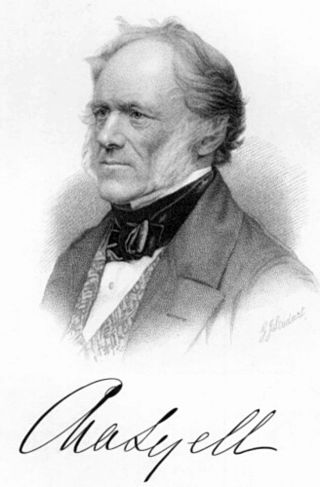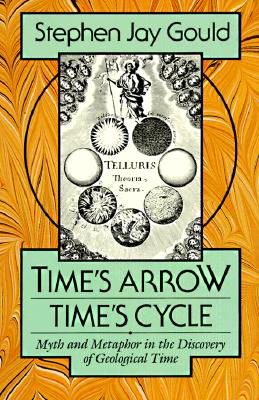
Sir Charles Lyell, 1st Baronet, was a Scottish geologist who demonstrated the power of known natural causes in explaining the earth's history. He is best known today for his association with Charles Darwin and as the author of Principles of Geology (1830–33), which presented to a wide public audience the idea that the earth was shaped by the same natural processes still in operation today, operating at similar intensities. The philosopher William Whewell dubbed this gradualistic view "uniformitarianism" and contrasted it with catastrophism, which had been championed by Georges Cuvier and was better accepted in Europe. The combination of evidence and eloquence in Principles convinced a wide range of readers of the significance of "deep time" for understanding the earth and environment.
Gradualism, from the Latin gradus ("step"), is a hypothesis, a theory or a tenet assuming that change comes about gradually or that variation is gradual in nature and happens over time as opposed to in large steps. Uniformitarianism, incrementalism, and reformism are similar concepts. For the Social democratics, the socialist society is achieved through gradualism.

Uniformitarianism, also known as the Doctrine of Uniformity or the Uniformitarian Principle, is the assumption that the same natural laws and processes that operate in our present-day scientific observations have always operated in the universe in the past and apply everywhere in the universe. It refers to invariance in the metaphysical principles underpinning science, such as the constancy of cause and effect throughout space-time, but has also been used to describe spatiotemporal invariance of physical laws. Though an unprovable postulate that cannot be verified using the scientific method, some consider that uniformitarianism should be a required first principle in scientific research. Other scientists disagree and consider that nature is not absolutely uniform, even though it does exhibit certain regularities.

Jean Léopold Nicolas Frédéric, Baron Cuvier, known as Georges Cuvier, was a French naturalist and zoologist, sometimes referred to as the "founding father of paleontology". Cuvier was a major figure in natural sciences research in the early 19th century and was instrumental in establishing the fields of comparative anatomy and paleontology through his work in comparing living animals with fossils.

In geology, catastrophism is the theory that the Earth has largely been shaped by sudden, short-lived, violent events, possibly worldwide in scope. This contrasts with uniformitarianism, according to which slow incremental changes, such as erosion, brought about all the Earth's geological features. The proponents of uniformitarianism held that the present was "the key to the past", and that all geological processes throughout the past resembled those that can be observed today. Since the 19th-century disputes between catastrophists and uniformitarians, a more inclusive and integrated view of geologic events has developed, in which the scientific consensus accepts that some catastrophic events occurred in the geologic past, but regards these as explicable as extreme examples of natural processes which can occur.

Timeline of paleontology
Deep time is a term introduced and applied by John McPhee to the concept of geologic time in his book Basin and Range (1981), parts of which originally appeared in The New Yorker magazine.

William Buckland DD, FRS was an English theologian who became Dean of Westminster. He was also a geologist and palaeontologist.

Robert Jameson FRS FRSE was a Scottish naturalist and mineralogist.

Flood geology is a pseudoscientific attempt to interpret and reconcile geological features of the Earth in accordance with a literal belief in the Genesis flood narrative, the flood myth in the Hebrew Bible. In the early 19th century, diluvial geologists hypothesized that specific surface features provided evidence of a worldwide flood which had followed earlier geological eras; after further investigation they agreed that these features resulted from local floods or from glaciers. In the 20th century, young-Earth creationists revived flood geology as an overarching concept in their opposition to evolution, assuming a recent six-day Creation and cataclysmic geological changes during the biblical flood, and incorporating creationist explanations of the sequences of rock strata.

Philosophie Zoologique is an 1809 book by the French naturalist Jean-Baptiste Lamarck, in which he outlines his pre-Darwinian theory of evolution, part of which is now known as Lamarckism.
Plutonism is the geologic theory that the igneous rocks forming the Earth originated from intrusive magmatic activity, with a continuing gradual process of weathering and erosion wearing away rocks, which were then deposited on the sea bed, re-formed into layers of sedimentary rock by heat and pressure, and raised again. It proposes that basalt is solidified molten magma. The theory lead to plutonic (intrinsic) rock classification, which includes intrinsic igneous rocks such as gabbro, diorite, granite and pegmatite. The name plutonism references Pluto, the classical ruler of the underworld and the Roman god of wealth. A main reason Pluto was incorporated into the classification was due to the plutonic rocks commonly being present in gold and silver ore deposits (veins).

Time's Arrow, Time's Cycle: Myth and Metaphor in the Discovery of Geological Time is a 1987 history of geology by the paleontologist Stephen Jay Gould, in which the author offers a historical account of the conceptualization of Deep Time and uniformitarianism using the works of the English theologian Thomas Burnet, and the Scottish geologists James Hutton and Charles Lyell.

The history of paleontology traces the history of the effort to understand the history of life on Earth by studying the fossil record left behind by living organisms. Since it is concerned with understanding living organisms of the past, paleontology can be considered to be a field of biology, but its historical development has been closely tied to geology and the effort to understand the history of Earth itself.

The history of geology is concerned with the development of the natural science of geology. Geology is the scientific study of the origin, history, and structure of the Earth.

A geologist is a scientist who studies the solid, liquid, and gaseous matter that constitutes Earth and other terrestrial planets, as well as the processes that shape them. Geologists usually study geology, earth science, or geophysics, although backgrounds in physics, chemistry, biology, and other sciences are also useful. Field research is an important component of geology, although many subdisciplines incorporate laboratory and digitalized work. Geologists can be classified in a larger group of scientists, called geoscientists.
Scriptural geologists were a heterogeneous group of writers in the early nineteenth century, who claimed "the primacy of literalistic biblical exegesis" and a short Young Earth time-scale. Their views were marginalised and ignored by the scientific community of their time. They "had much the same relationship to 'philosophical' geologists as their indirect descendants, the twentieth-century creationists." Paul Wood describes them as "mostly Anglican evangelicals" with "no institutional focus and little sense of commonality". They generally lacked any background in geology, and had little influence even in church circles.

The Macellum of Pozzuoli was the macellum or market building of the Roman colony of Puteoli, now the city of Pozzuoli in southern Italy. When first excavated in the 18th century, the discovery of a statue of Serapis led to the building being misidentified as the city's serapeum or Temple of Serapis.
The discovery of human antiquity was a major achievement of science in the middle of the 19th century, and the foundation of scientific paleoanthropology. The antiquity of man, human antiquity, or in simpler language the age of the human race, are names given to the series of scientific debates it involved, which with modifications continue in the 21st century. These debates have clarified and given scientific evidence, from a number of disciplines, towards solving the basic question of dating the first human being.















